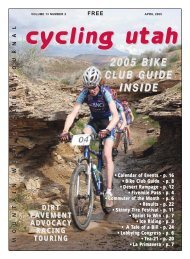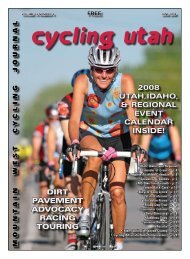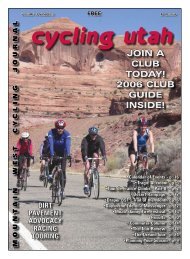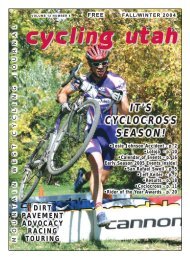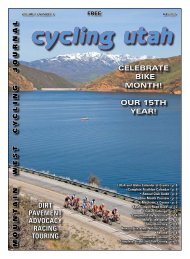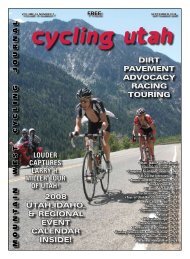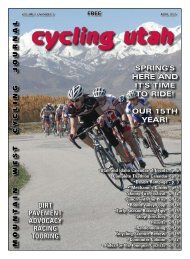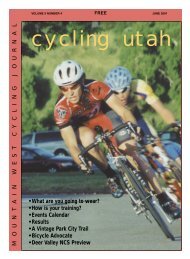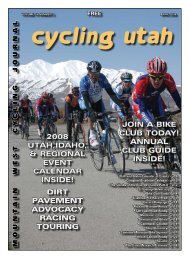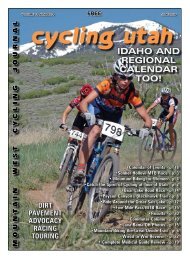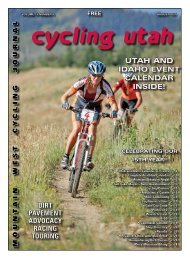You also want an ePaper? Increase the reach of your titles
YUMPU automatically turns print PDFs into web optimized ePapers that Google loves.
JULY <strong>2007</strong> cycling utah.com 5<br />
HEALTH<br />
The Role of Your Tendons and<br />
How to Keep Them Healthy<br />
By Erik Moen PT, CSCS<br />
Tendons are for transferring<br />
muscular torque to your bones.<br />
Tendons attach your muscles to your<br />
bones. Tendons help transfer force<br />
for the purposes of pedaling your<br />
bicycle and to create joint stability.<br />
When you an injure a tendon<br />
this is considered a tendinopathy.<br />
Tendinopathies are somewhat<br />
common for endurance athletes.<br />
Tendinopathies occur when a tendon<br />
is exposed to a chronic and/or irregular<br />
force relative to the strength of<br />
the tendon. Tendons that attach near<br />
the knee are common sites for overuse<br />
injuries. Being aware of your<br />
tendon structure, function, dysfunction,<br />
and repair will better prepare<br />
you for healthy activity participation<br />
and successful tolerance of torque<br />
production (speed!).<br />
Structure<br />
Tendon is made from a serial<br />
array of tiny fibers that make up<br />
a rope-like structure. Tendon<br />
is primarily made of a material<br />
called collagen. Collagen is your<br />
body’s source of fiber. Tendon is a<br />
dynamic tissue. It changes structure<br />
and strength in the presence and/or<br />
absence of load. This dynamic<br />
nature of tendon is considered “tissue<br />
mechanical adaptation” for those<br />
in the mechanobiology-world.<br />
Summary: Tendon is essentially<br />
a rope.<br />
Overload<br />
SnowbirdBHCAd07<br />
Tendon tends to strengthen<br />
6/20/07<br />
when microtrauma. If the tendon is generally<br />
stretched over 4%, microscopic<br />
3:39 PM Page 1<br />
exposed to increased levels of load<br />
or torque. This is not an instanta-<br />
tearing of tendon fibers occurs.<br />
neous process, but rather happens<br />
over time (weeks, months and<br />
years). Tendon changes it’s structure<br />
due to the presence of consistently<br />
higher loads and becomes better<br />
capable of accepting load. Cells<br />
in tendon called fibroblasts produce<br />
collagen at a greater rate than the<br />
old collagen is broken down when<br />
exposed to consistent and/or increasing<br />
loads.<br />
Summary: Tendons get strong<br />
with regular, progressive loading<br />
over time.<br />
Detraining<br />
De-training or immobilization of<br />
a tendon creates a lack of load stimulus<br />
to a tendon. Studies of tendon<br />
immobilization demonstrate the loss<br />
of total tendon weight, stiffness, and<br />
tensile strength. Significant structural<br />
changes to tendon were seen in<br />
various animal models following 3-4<br />
weeks of relative immobilization.<br />
Immobilization was also found to<br />
create irregular and uneven collagen<br />
fibers, dilated veins and capillaries.<br />
For example, if I were to “pull a<br />
Brian Wilson” for 3 weeks and then<br />
go out to the velodrome and try to<br />
race with the local heroes, I might<br />
end up with a tendinopathy.<br />
Summary: Use it or lose it!<br />
Overuse:<br />
Overuse of a tendon refers to a<br />
repetitive stretching of a tendon that<br />
results in an inability to endure further<br />
tension. Excessive and chronic<br />
tension to a tendon will result in<br />
Beyond 8–10% strain, macroscopic<br />
failure occurs. And further stretch<br />
causes tendon rupture. Consistent<br />
microtrauma will result in inflammation.<br />
Inflammation has been<br />
classically defined as redness, pain,<br />
heat and swelling. Tendon injuries<br />
are most known for their pain. You<br />
know you are in trouble with your<br />
tendonitis when it limits your ability<br />
to perform your activity/sport<br />
or simple activities of daily living,<br />
such as going up and down stairs.<br />
Some inflamed tendons will actually<br />
“crunch” as they move. This is<br />
known as crepitus. Tendon injuries<br />
will most often be point tender and<br />
create pain when you put a load<br />
through them. If your tendon pain<br />
becomes painful even when you are<br />
at rest, this is a pretty bad sign. This<br />
level of tendon pain means a longer<br />
road to recovery. Initial onset of<br />
tendonitis is tricky because the pain<br />
of tendonitis will lessen with the<br />
performance of activity making you<br />
feel like you don’t have an injury.<br />
You will note however that the pain<br />
will come back, most likely worse<br />
than before.<br />
Summary: Chronic, progressive<br />
tendon pain means no gain!<br />
Repair<br />
Tendons can heal with exposure<br />
to a good environment. There are<br />
three overlapping phases of tendon<br />
repair, inflammation, repair and<br />
remodeling. A single “insult” injury<br />
results in an initial 24 hour period<br />
of inflammation that creates a cellular<br />
reaction. This cellular reaction<br />
assembles the cellular and chemical<br />
environment for the preparation<br />
of repair. A few days following<br />
the injury, the repair phase begins.<br />
Fibroblasts begin to lay down new<br />
collagen fibers. After 6 weeks following<br />
the injury, the remodeling<br />
phase begins. This is when the<br />
production of collagen slows down.<br />
Water content of the healing tissue<br />
becomes less and the repairing tendon<br />
becomes more fibrous. At 10<br />
weeks the repair site becomes more<br />
scar-like. Scar is known for it’s<br />
disorganized nature upon its initial<br />
deposition. Scar responds to stress<br />
and strain. In fact a controlled exercise<br />
program after the initial inflammation<br />
stage is indicated for better<br />
healing of a tendon injury. Thus<br />
the repair and remodeling phases<br />
following an injury become very<br />
important. A well-remodeled scar<br />
will allow for better load tolerance<br />
of a tendon in the future.<br />
Summary: Resumption of<br />
loading is important but not at the<br />
expense of “fanning the flames” of<br />
inflammation.<br />
What do I do if I develop<br />
tendonitis?<br />
Basic treatment strategies for<br />
acute tendonitis pain include ice and<br />
relative rest. Tendon healing can<br />
begin with the cessation of irregular,<br />
pain-producing load to the tendon.<br />
Once diagnosed with tendonitis,<br />
consider getting an evaluation of<br />
flexibility, strength and coordination.<br />
Take this opportunity to discover<br />
why you developed an overuse<br />
injury. Your discoveries of deficiencies<br />
will allow you to best plan your<br />
road of recovery. An adapted exercise<br />
plan is the next step for tendonitis<br />
resolution. Tendonitis responds<br />
well to pain free stretching and progressive<br />
eccentric muscle loading.<br />
Have a Sports Physical Therapist<br />
help you with this type of program.<br />
All exercise should start pain free.<br />
Keep track of your exercise “dose”<br />
so as to better figure next steps in<br />
tissue loading. Your gains will not<br />
always be linear in nature, meaning<br />
you will most likely not be able to<br />
“add 5 reps a day” with this plan.<br />
What now?<br />
Tendon is a dynamic tissue. You<br />
have to “use it smartly or lose it”<br />
for tendon health. Tendon keeps<br />
its health when it is exposed to a<br />
reasonable load. Tendon is best<br />
prepared for activity when it is<br />
gradually introduced or exposed<br />
to load. Slowly work up to your<br />
desired levels of activity. Tendon<br />
strength development is partially<br />
why the required training process<br />
takes so long. Weight training may<br />
be used to increase tensile loading<br />
capacity of tendon. The inclusion<br />
of a weight training regimen for<br />
the endurance bicyclist typically<br />
occurs in the Fall. Flexibility is also<br />
an important component of tendon<br />
health. Poor flexibility in relation to<br />
your activity can put an additional<br />
load to your tendons. Avoidance of<br />
tendinopathies requires a proactive<br />
approach. Planning for your projected<br />
load and motion requirements<br />
will maintain the health of your<br />
tendons.<br />
References:<br />
Wang JH-C. Mechanobiology of<br />
tendon. Journal of Biomechanics<br />
2006 Vol 39 pp.1563–1582.<br />
Butler DL, Grood ES, Noyes FR,<br />
Zernicke RF, Biomechanics of ligaments<br />
and tendons. Exercise and<br />
Sport Sciences Reviews 1978 Vol 6,<br />
pp. 125–181.<br />
Erik Moen PT, CSCS is Physical<br />
Therapist, an Elite-level coach<br />
with the United States <strong>Cycling</strong><br />
Federation and an occasional racer<br />
in cyclocross and velodrome racing.<br />
Erik's physical therapy practice<br />
has an emphasis on orthopedic<br />
rehabilitation, bicycle related injury<br />
intervention and bicycling performance.<br />
He can be found online at<br />
bikept.com.<br />
29th snowbird<br />
Bicycle<br />
Hill Climb<br />
1st Ultra aug. 18<br />
Widow Maker<br />
Mountain Bike Race<br />
15miles—6,500 vert. ft.<br />
au g. 18<br />
&<br />
One of the oldest road races in <strong>Utah</strong>!<br />
info:<br />
10 miles—<br />
3,500 vert. ft.<br />
enter:<br />
BICYCLE HILL CLIMB - AUGUST 18, <strong>2007</strong><br />
Starts: Competitive 8 a.m.; Citizen 8:05 a.m.; Pro 8:15 a.m. UTA Park & Ride (2000 East 9400<br />
South). Finish: Snowbird Entry 2<br />
Hill Climb Registration: $30 through August 16; $35 night before at the start; $40 day of at the start.<br />
SPORTS BASE ONLINE IS OFFERING A<br />
$250 CASH PRIZE<br />
IN THE PRO CATEGORY<br />
ULTRA WIDOW MAKER MOUNTAIN BIKE RACE - AUGUST 18, <strong>2007</strong><br />
(Bike switching area provided) Starts: Competitive 8 a.m.; Citizen 8:05 a.m.;<br />
Pro 8:15 a.m. UTA Park & Ride (2000 East 9400 South). Finish: Hidden Peak<br />
Ultra Widow Maker Registration: $40 through August 16; $45 night before at the start;<br />
$50 day of at the start.<br />
Register at Canyon Bicycles, 3969 S. Wasatch in Holladay after <strong>July</strong> 1<br />
and pick up your T-shirt and bib number. Registration forms for both<br />
races are available at most local bike shops and may be downloaded<br />
at snowbird.com.<br />
Register online at sportsbaseonline.com<br />
For more information on the BHC call Snowbird 933-2110; for the UWM call Sports Am: 583-6281.<br />
Fill out this form and mail it with your check made out to Snowbird Special Events to:<br />
Snowbird Special Events, P.O. Box 929000, Snowbird, <strong>Utah</strong> 84092-9000<br />
Check event you are entering: Hill Climb <strong>2007</strong> Ultra Widow Maker <strong>2007</strong> <br />
(Competitive riders ONLY: Place category CAT__________ )<br />
Name___________________________________ Age______<br />
Female Male <br />
Address _______________________________________________________________<br />
City_______________________________________ State______ Zip______________<br />
Phone__________________ E-mail_____________________ Unisex T-Shirt size_____<br />
THIS IS A LEGAL CONTRACT: In consideration of accepting this entry, I intending to be legally bound, do hereby for myself, my heirs,<br />
executors and administrators waive and release any and all claims for damages, including personal injuries to me or wrongful death, I may<br />
accrue against Snowbird, Sports Am, State of <strong>Utah</strong>, <strong>Utah</strong> Department of Transportation, <strong>Utah</strong> Transportation Commission, <strong>Utah</strong> Highway<br />
Patrol and all persons and organizations affiliated with the race(s) for any and all injuries that may be suffered by me during or en route<br />
to or from the event(s). I attest that I am physically fit and sufficiently trained for this competition. My physical condition has been verified<br />
by a licensed physician in the last 6 months. As part of this contract, I acknowledge that I have read and understand all of the above.<br />
Signature of Entrant _______________________________ Date__________________<br />
(Parent/Guardian if under 18)



